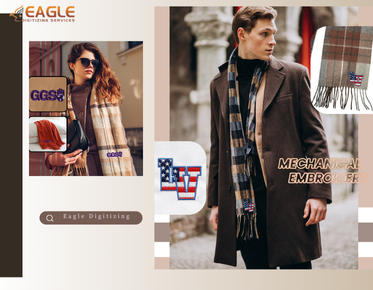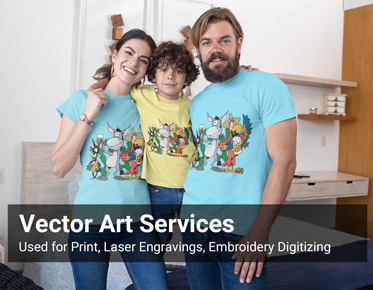Exploring Different File Formats for Every Embroidery Project
When diving into
the world of digitized embroidery, one of the
most pivotal decisions revolves around file formats. Just as choosing the right
canvas is essential for a painter, selecting the correct file format can
significantly influence the quality, compatibility, and overall success of your
embroidery projects. With an array of options available, understanding the
nuances of each format is crucial. This article will guide you through the
essential file formats used in digitized embroidery, empowering you to make
informed decisions tailored to your creative needs.
Why File Formats Matter: Impact
on Quality and Compatibility
Digitized
embroidery transforms intricate designs into stitch patterns that machines can
interpret. This process relies heavily on file formats, which dictate how the
design data is stored and utilized. Choosing the right format is vital, as it
affects everything from the quality of the final embroidery to the
compatibility with your machine. An unsuitable file format can lead to
misalignment, poor stitch quality, and even machine malfunctions. Thus, an
understanding of different file formats is essential for achieving your
artistic vision without unnecessary complications.
Common File Formats in Digitized
Embroidery: An Overview
Several file
formats dominate the landscape of digitized embroidery, each with unique
characteristics tailored to different machines and purposes. Below are some of
the most widely used formats:
PES:
The Popular Choice for Brother Machines
The format that
Brother embroidery machines prefer to use is PES files. They offer extensive
features, including color information and stitch types, making them versatile
for various projects. Their compatibility with a wide range of embroidery
software further solidifies their popularity among crafters.
DST:
A Universal Standard for Embroidery Files
DST files have
earned their reputation as an industry standard. Developed by Tajima, they are
universally recognized and compatible with numerous embroidery machines.
However, they lack the advanced features found in other formats, such as color
information, which can limit their versatility in complex designs.
EXP:
A Format for Melco Machines
EXP files are
specifically designed for Melco embroidery machines, catering to users who
require precision and detail in their designs. This format supports complex
stitching techniques and provides a comprehensive set of features tailored for
professional embroidery applications.
JEF:
The Go-To for Janome Machines
JEF files are
primarily used with Janome embroidery machines, providing a straightforward
solution for home embroiderers. While they may not boast as many features as
PES or EXP files, they are reliable and easy to use, making them a popular
choice for hobbyists.
In-Depth Look at PES Files: Pros
and Cons
Advantages
of Using PES Files: Compatibility and Features
PES files are
renowned for their compatibility with various embroidery software and machines,
particularly Brother models. They support rich color palettes, detailed stitch
types, and customizable settings, making them highly versatile for intricate
designs. Their widespread use means that many resources are available for
users, facilitating learning and troubleshooting.
Disadvantages
to Consider: Limitations and Workarounds
Despite their
advantages, PES files have some limitations. They can become cumbersome when
dealing with extremely large files, as the complexity can slow down processing
speeds. Additionally, certain machines may have difficulty reading PES files if
they contain too many intricate details. However, with careful design planning
and software adjustments, these challenges can often be mitigated.
Best
Uses for PES Files in Your Projects
PES files are ideal for projects requiring a rich array of colors and detailed designs. They excel in creating complex logos, personalized monograms, and elaborate artwork that demands precision. If you're working with Brother machines, leveraging PES files will maximize your machine's capabilities.
Decoding DST Files: The Industry
Standard
Why
DST Files Are Widely Used: Understanding Their Popularity
DST files are a
staple in the embroidery industry due to their
universal compatibility across various machines. As a format primarily
developed for Tajima machines, it has become the go-to choice for many
professional embroiderers. Their straightforward structure allows for easy
handling and reliable results, making them a popular option for bulk embroidery
projects.
Limitations
of DST: What You Should Know
While DST files
are widely respected, they do have their drawbacks. Notably, they do not
support color information, meaning that users must specify colors during the
stitching process, often leading to potential mismatches. Additionally, DST
files can struggle with intricate designs due to their limited stitch type
options, which may restrict artistic expression in more complex projects.
Ideal
Applications for DST Files
DST files are
perfect for high-volume production runs, such as uniforms or promotional items.
Their efficiency and compatibility make them suitable for projects requiring
quick turnaround times. For simpler designs, such as text or basic logos, DST
files can provide an effective solution.
Exploring EXP Files: For Melco
Users
The
Unique Features of EXP Files: Benefits for Specific Machines
EXP files stand
out for their tailored features specifically designed for Melco embroidery
machines. They allow for high-quality stitching
and support complex designs that require precision. This format is beneficial
for professionals who demand exceptional quality and detail in their embroidery
work.
Common
Challenges with EXP Files: Navigating Limitations
Despite their
advantages, EXP files come with challenges. Some users may find the learning
curve steep when working with specialized software required for EXP file
manipulation. Furthermore, not all embroidery machines can read EXP files,
limiting their versatility compared to more universal formats like DST.
Best
Practices for Working with EXP Files
To maximize the
benefits of EXP files, users should familiarize themselves with their specific
Melco machine and the accompanying software. Regular updates to the software
can improve compatibility and functionality. Additionally, conducting test
stitches with EXP files can help identify any potential issues before
committing to a final project.
Getting to Know JEF Files: A
Janome Favorite
Why
JEF Files Stand Out for Janome Users
JEF files are the
preferred choice for Janome machines due to their simplicity and reliability.
They are user-friendly and compatible with various embroidery software, making
them accessible to both beginners and experienced embroiderers. This format is
particularly suited for home use, where convenience is a priority.
The
Pros and Cons of Using JEF Files
While JEF files
offer ease of use, they do have limitations. The file format may not support as
many advanced features as PES or EXP files, which can hinder complex designs.
Nevertheless, JEF files excel in their simplicity, making them a great option
for straightforward embroidery projects.
Tips
for Optimizing JEF Files for Your Embroidery Projects
To optimize JEF
files, it’s essential to keep designs simple and focused. Limiting intricate
details will help ensure clarity in the final product. Additionally, using the
appropriate fabric and thread can enhance the appearance of the finished
embroidery, maximizing the effectiveness of JEF files.
Alternative Formats: Expanding
Your Options
ART
Files: The Embroidery Format for Bernina Machines
ART files are
specifically designed for Bernina embroidery machines, providing advanced
features that cater to high-quality stitching. This format allows for intricate
designs and supports a variety of stitch types, making it a solid choice for
professionals seeking detail.
VIP
and VP3: For Pfaff and Husqvarna Viking Users
VIP and VP3 files
are popular among users of Pfaff and Husqvarna Viking machines. These formats
support a range of stitch types and are particularly effective for creating
colorful and complex designs. Both formats are compatible with a variety of
embroidery software, offering flexibility in project execution.
CND
and HUS: Other Formats Worth Knowing
CND and HUS files
are additional formats that may be beneficial for specific embroidery machines.
CND files cater to certain models, while HUS files are widely compatible with
Husqvarna machines. Understanding these formats can help expand options and
improve project outcomes.
Choosing the Right Format for
Your Embroidery Needs
Understanding
Your Machine's Requirements: Compatibility Is Key
Before selecting
a file format, it’s essential to understand the requirements of your embroidery
machine. Each machine has specific compatibility needs, and choosing the right
format ensures seamless operation. Always consult the user manual or
manufacturer guidelines to ensure optimal performance.
Project
Considerations: What Will You Be Embroidering?
Consider the
nature of your project when choosing a file format. Are you creating intricate
designs or simple text? Understanding your project’s demands will help narrow
down the best file format for your needs. Taking the time to assess the project
will yield better results in the final embroidery.
Quality
vs. Convenience: Finding the Balance
When selecting a
file format, striking a balance between quality and convenience is crucial.
While some formats may offer advanced features, they may also come with a
steeper learning curve. Conversely, simpler formats may limit design
complexity. Ultimately, understanding the trade-offs involved will enable you
to make an informed choice tailored to your unique embroidery needs.
Converting Between Formats: When
and How to Do It
Why
You Might Need to Convert File Formats
There are several
reasons why converting between file formats may become necessary. Perhaps you
need to switch to a more compatible format for a different machine or software.
Alternatively, you may want to optimize a design for a specific project.
Regardless of the reason, understanding how to convert files effectively is
essential for smooth operation.
Tools
for Converting Embroidery
Files: Top Software Options
Various software
options are available for converting embroidery file formats. Popular choices
include Wilcom, Embird, and SewArt, which provide user-friendly interfaces and
comprehensive features. Selecting the right tool will facilitate seamless
conversions, ensuring that your designs maintain their integrity throughout the
process.
Tips
for Successful Conversions: Avoiding Common Pitfalls
When converting
embroidery files, it’s essential to double-check design details
post-conversion. Adjust stitch types, colors, and layouts as needed to ensure
the final output aligns with your original vision. Always conduct test stitches
to confirm that the converted file performs as expected, helping you avoid
potential pitfalls in the final production.
Troubleshooting Common Issues
with File Formats
Misaligned
Designs: How File Format Affects Alignment
Misalignment is a
common issue in embroidery, often influenced by the file format. If a design is
not properly aligned, it can lead to unsightly results. To avoid this, ensure
the file format you’re using is compatible with your machine and consider
conducting test stitches to verify alignment before proceeding with full
production.
Stitch
Quality Problems: Identifying Format-Related Issues
Stitch quality
can be affected by various factors, including the file format. If you notice
uneven stitching or skipped stitches, it may be a sign that the file format is
not suited for your machine. Reviewing the file settings and conducting
adjustments can help improve stitch quality and overall performance.
How
to Fix Common Format Errors
Addressing common
format errors requires a systematic approach. Start by identifying the specific
issue, whether it’s misalignment, stitch quality, or color discrepancies. Make
necessary adjustments within your embroidery software, and always perform test runs
to ensure that the final product meets your standards.
Ultimately, the
right file format can transform your embroidery experience, leading to
successful and stunning outcomes. Embrace the learning journey, explore
different formats, and let your creativity shine through in every stitch. With
the proper knowledge, you can confidently approach your digitized embroidery projects, bringing your artistic visions to
life.


.png)
